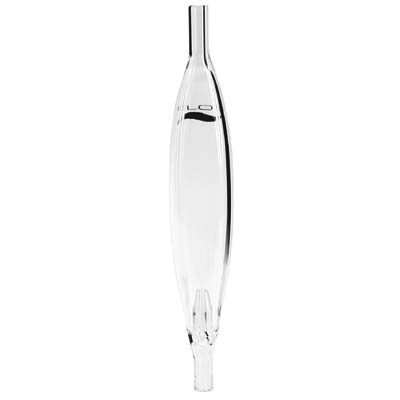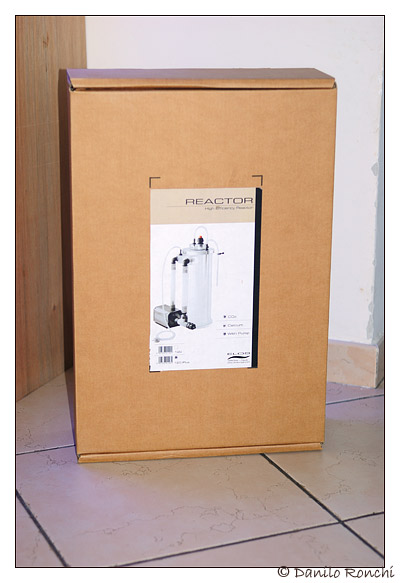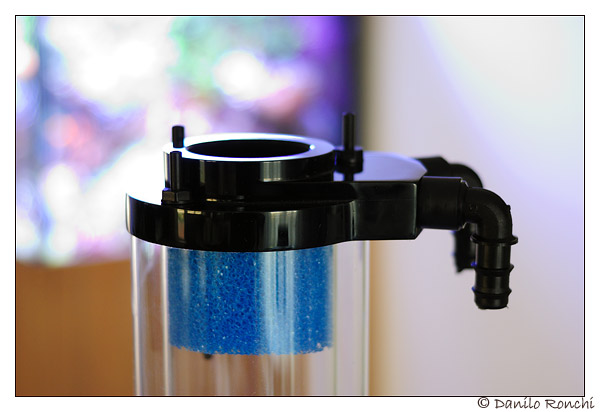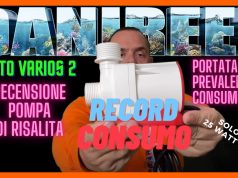After writing in the last month of two calcium reactors Korallin C-1501 and C-3001, I am going to review another calcium reactor, the Elos REA120 Plus. With this reactor, I have replaced the previous largest Korallin and I used it on my 400 liter tank filled with hard corals, and I’ve tried using both arm and natural CaCO3 media.

The photo shows the REA120 Plus just busted by the usual Elos pack, shown on the right. As usual the Elos packaging is fully accurate. The reactor is large and it is beautiful to see thanks to construction made of plexiglass and the many pieces turned from a solid, although it is obvious that to many aquarists the construction materials and care often are only marginally relevant.
Technically, the reactor operates with a single pump, a generous Eheim 1260, which deals with both taking tank water and recirculating inside, thanks to the generous flow values and head (2,400 liters / hour, 3.7 meters ).
 Inside the packaging there is the calcium reactor, the pump, a small booklet of use, a glass bubble counter, a special plastic check valve completely dismantled, and all necessary silicone connections for the efficient reactor operation.
Inside the packaging there is the calcium reactor, the pump, a small booklet of use, a glass bubble counter, a special plastic check valve completely dismantled, and all necessary silicone connections for the efficient reactor operation.
Caratteristiche tecniche:
| Elos REA 120 Plus | |
| Reactor height | 620 mm |
| External pipe diameter | 125 mm |
| Internal pipe diameter | 90 mm |
| Pump | Eheim 1260 |
| Height free to fill | ~ 42 cm |
| Capacity | 2,7 litri |
| Street Price (Italy Store) | 865 euro |
The reactor was used, like the Koralline C-3001, for my tank which (you can see one picture) and was able to maintain a stable calcium level between 400 and 450 ppm for several months.

Constructively Elos REA 120 Plus has a hole for one probe over its top for being controlled by controller, and the upper cap can be easily unscrewed to allow us to manage the reactor filling material.
Inside, there are sponges that prevent fill material must to be in contact with the pump.
The structure of the reactor is different from what we usually see, this is because the outer chamber serves as a recirculate circuit for water filled by CO2 to increase its final yield.
How it can be used
The reactor can operate in two different ways depending on how you choose to connect the two pipes present, thanks to the double inner chamber which is fitted. The filling material is inserted into the inner chamber and if you choose the mode “in pressure”, the CO2 is fed into the outer chamber where it comes into contact with water and mixed with it through the powerful Eheim 1260. In the inner chamber, the filling material will therefore always be in contact with water very acidic, and dissolves slowly releasing calcium into the water.
Thanks to a dual chamber, the CO2 which has not been completely mixed will be taken up by the pump and injected back into the outer chamber of the reactor, working as a highly efficient system for recycling of CO2. In this way the yield of the reactor is up and you get the most from CO2 consumed. The importance of high pressure in the outer chamber leads to a perfect blend between CO2 and water, avoiding contact with the water free of CO2 aquarium, so all the CO2 is used for the dissolution of calcareous material.
Otherwise you can connect the reactor in an opposite way, by including water and CO2 into the inner chamber as a normal gravitational reactor, in this way, though the yield decreases, the reactor is more easily controlled in the case of aquariums not particularly full of hard corals, and that do not need a high yield.
Setting up
The reactor is fairly simple to assemble, although the possibility of connection in two different ways, in pressure and gravity, can confuse inexperienced aquarist. There are sponges for the bottom and the top of the reactor to prevent the filling material comes in contact with the pump, among which must obviously include the material of choice. Then you must connect the pump through the two silicone tubes supplied. At the head of this pump is a T-fitting is used to draw water from the aquarium, while the silicone tube connected directly to the upper body of the pump will push the water pressure inside the reactor.

As we have seen before you can connect the two tubes in one direction (the pump that pushes into the inner chamber – a gravity method) or another (pump that pushes the outer chamber – pressure method), then you need to connect the various superior silicone pipes in accordance with instructions. A tube will act as a bypass between the inner and outer chamber, a tube directly over the top will be used to put the water from reactor to sump, while the last tube will be connected with the CO2.

The quality of the plexiglass and the bonding is clearly exciting, it’s a pity to put such an object in the sump, only considering the construction materials used and the care used.
As seen in photos all the pipes are connected by simple pressure, there are no parts to be screwed if we exclude the center cap and the hole for the probe is also useful to make a degassing of the interior of the reactor in case if the need arises.
The reactor could also be mounted outside the sump, but from personal experience in this case I would tend to add a sump pump that pushes the water inside the reactor, or I’d use a deviation from the return pump, otherwise the large Eheim will tend to maintain recirculation in the reactor and will fail to suck water from the sump.
The upper cap is screwed to the main body from which it is sealed by a large O-ring, thus making it very easy operation of filling and refilling, for emptying is obviously still need to extract the reactor from sump and turn it over elsewhere. As there are no metal pieces then the reactor is perfectly safe in its placement within the sump.

Manual Setting
The adjustment of the reactor must be done manually by adjusting the number of bubbles of CO2 input through the pressure reduction valve balanced with drops in output from the reactor through a plastic tap.
I usually recommend starting with two bubbles of CO2 every second and a one drop per second as output. The management of CO2 will adjust the pH while management of the drops it will set the total balance. In order to properly calibrate the reactor will proceed to measure the values of Ca, Kh and Mg before entering the reactor itself, then we will proceed to assembly and setting as referred above, or in any other way, then you should wait at least a day before making the second measurement, one in a tank and one just outside the reactor, to see if the contents of Ca and Kh is sufficient.

At this point we compare the output values from the reactor in comparison with those in the tank. To get a good efficiency, the reactor should have dKh greater than 30 outgoing, so if the second measure of dKH is lesser we need to increase the bubbles of CO2 entering, without adjusting the drops in output. We will wait for a day and we will do measurement again. Once the dKh will be greater than 30 (but 35 or 40 is good), we will compare the value of Ca in the tank measured before mounting the reactor and after mounting it. If the value has dropped it we need boost output, if the value is identical it’s okay, if the value is increased too much you can slightly reduce the number of drops in output. At this point we have a little problem, because varying the outflow varies the percentage of CO2 dissolved in the reactor, as with the same amount of CO2 we will have greater or lesser amount of water. We need therefore adjust slightly bubbles of CO2 in agreement with the increase or decrease the flow. Don’t worry if your reactor will demand more CO2… with this reactor is quite normal.
We need also to consider that with time our corals will grow and will need more calcium and so you need to occasionally recalibrate the reactor, also gradually the media inside reactor will consume and so the efficiency of reactor will decrease, to avoiding this I advice you to keep the reactor full or at least 3/4 full and refill it often, also because it’s a very simple task.
To simplify the administration of calcium reactor it is possible to connect a pH probe, in order to handle the amount of CO2 into the reactor through a valve controlled by a pH meter. In this way the management is apparently simpler, but hides pitfalls. First of all you need to calibrate the pH probe very thick (about 1 time per month for best results and to replace it every 2 years) because they tend to loose their calibration, it is also necessary to include in our management one valve and one pH controller having both cost of purchase, management and time. I however have always used the two reactors manually for over two years without any problems. In any case it’s possibile also to simply put the probe inside the reactor to read the value, so you can see if the reactor is working well.
I have to say that this reactor eats a lot of CO2, maybe for pressure mode, and so it’s possible your CO2 can finish in a very small amount of time compared to other reactors on the market.

The Eheim 1260 pump included is characterized, as we anticipated, from a static head of 3.7 meters, a flow of 2,400 liters / hour and a consumption rating of 65 watts. That translates into an estimated annual consumption equal to 569 kWh and a cost of 142 euros per year (counting EUR 0.25 per kWh). Consumption in any case not indifferent.
The reactor was built, however, considering the use of Ca-Pur, Elos filling media, which requires a very strong mixture, being very pure calcium carbonate with high propensity to be compacted if not properly maintained in motion. That is why I tried to use a smaller pump than the 1260. The choice is obviously fallen on a Eheim 1250 characterized by a static head of 2 meters, a capacity of 1200 liters per hour and consumes 28 watts nominal. That translates into an estimated annual consumption of 245 kwh, and a cost of 61 euros per year (counting EUR 0.25 per kWh). Consumption in this case much more accessible. In truth I would also like to try it with a pump even smaller, but so far I have not had the chance.
This reactor does not have a preferred filling material, as the pump supplied can work with any type of equipment, among others with the ability to use a smaller pump in case of using natural CaCO3 or Arm, materials that not require excessive fluidity, as I am doing.
My use of this reactor has not revealed any problems whatsoever, never blocking, apart the possibility of a block of output due to the deposit of calcium carbonate, probably amplified by not using a pump which maintains the entrance of the reactor under pressure, in this case you must open the clamp and drain the water rich in calcium excess.
The only problem of this reactor is in fact the consumption of CO2 is very high at least in a tank filled with corals like mine.
Conclusion
I believe the calcium reactor Elos REA120 an excellent all-purpose reactor. Complete with all equipment possible, capable of operating in two different modes to suit any use, ready to use a pH probe and built extremely well.
There is one characteristic that can not leave indifferent, the price is high, there are ways of getting around, you can buy a reactor from similar services by spending less than half what is required by Elos, a feature which then poses a often insurmountable barrier to its purchase. If we want to talk about value for money, unfortunately we did not, the reactor is too expensive. So why buy it? Because it is done well, because it is objectively beautiful and because it works well, last but not least because it is an exclusive product, and as such may represent the desire for someone.
For my personal experience I think the REA120 Plus suitable for tanks of hard corals up to 500 liters and when used in tanks with mixed corals or only soft coral it can handle double the capacity without major problems, in fact, adapting well to the requested range, thanks to its possibility to management by pressure or by gravity as we have seen.
The article was published on Magazine Acquaportal in the month of November:




















[…] [DaniReef] Posted in Reef News | Search More: elos • REA 120 • […]